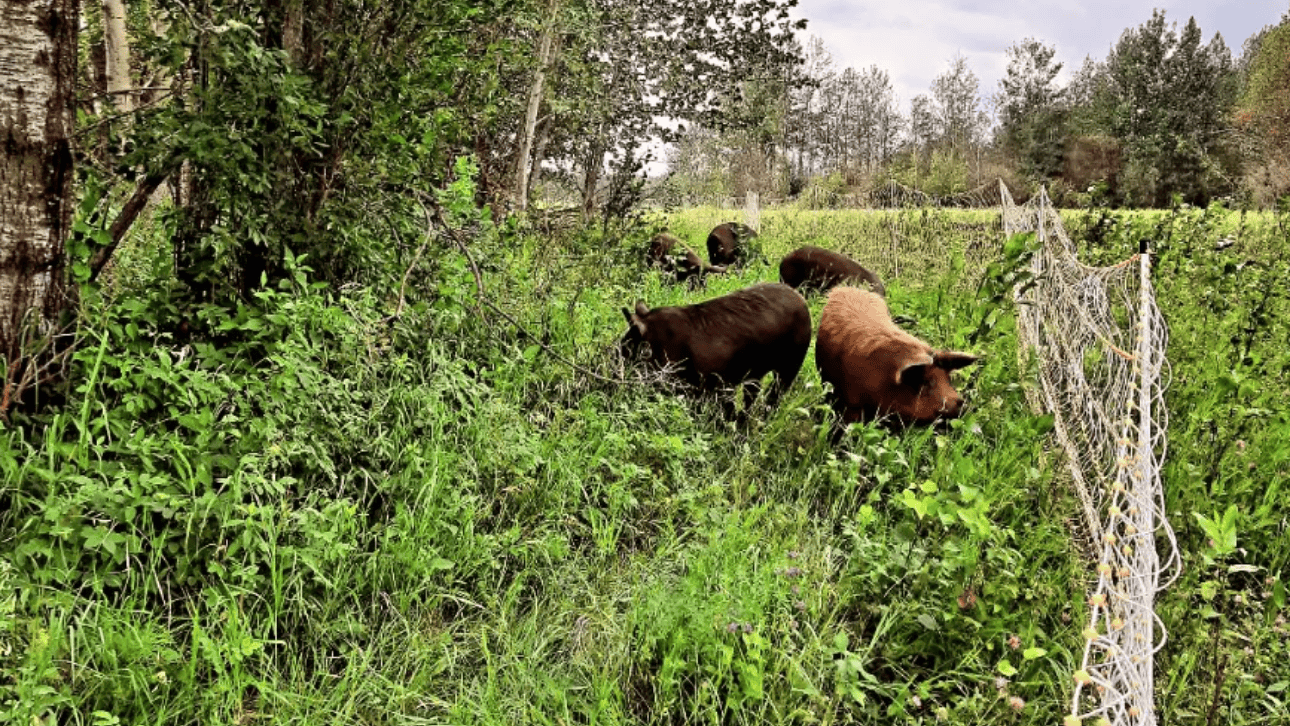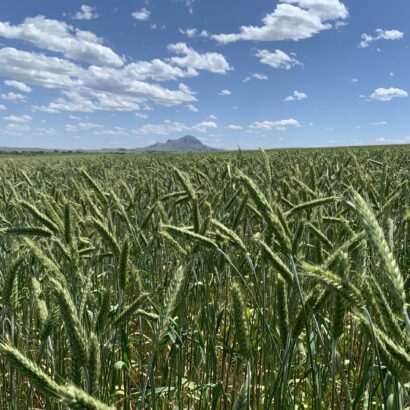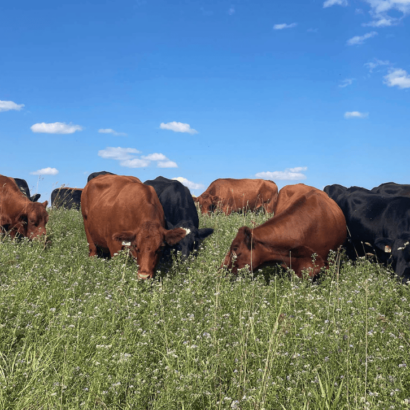Rocking T Farms pigs grazing on a forage mix. Photo courtesy of @rockingtfarm Instagram.
(CALGARY, AB, April 28, 2025) – Scott Todd of Rocking T Farms near Wildwood, Alberta says that a little extra time spent planting pays dividends in soil health and grazing opportunity throughout the season.
“What’s been really exciting for us is seeding with the seasons and getting the opportunity to seed all summer long. We are changing up our [seed] blends every two weeks depending on moisture levels and what time of the year it is.”
Todd, a self-proclaimed enthusiast about diverse seed mixes, says it may seem like a lot of time spent planting, but the process comes naturally to him and his operation.
“This time of year I’ve been frost seeding some annual ryegrass and some yellow blossom sweet clover, just trying to get the freeze-thaw cycle to suck up some of that seed in the thin spots from last year. And then around the first of May we’ll start seeding some oats, barley, and peas for the pigs. Once we get into the later part of May we’ll add in some polyculture crops for grazing in the fall – we’ll add in chicory, phacelia, plantain, and other things like that. Then into the beginning of June we’ll start adding warm-seasons into the mix, like sunflowers and buckwheat. By the end of June it’s a full warm-season mix with millets and things like that. By August we quit with the warm-season mixes and start planting winter triticale and hairy vetch,” he explained.
“As far as prepping the land for planting, it’s not a big deal. I wait until the pigs have disturbed a large area, and then I just get out there and smooth it out with the disc and harrow in the seed. And that’s about the extent of it,” Todd shared.
Todd comments that he could likely get away with only three mixes: a cool-season mix, a warm-season mix, and a fall-seeded mix, but he enjoys the process of customizing seed mixes for his operation.
“I love it. It’s kind of a pet project for me, honestly, just to try and learn. I’m trying to figure out what really grows well in our soils and our weather patterns and things like that. I like some of the blends Renovo Seed makes, like the Double Down Blend. As we go further into this I’m sure I’ll streamline it a lot more, but we’re kind of throwing the kitchen sink at it for now. It’s just a lot of fun.”
Focusing on soil health through livestock grazing
Todd’s multi-species livestock plan depends on the rotational grazing of the seed mixes he’s planting throughout the spring, summer, and fall.
“First, we bring a group of feeders onto our place every summer and we rotate them, trying to follow the regenerative principles and adaptive grazing principles. We have high stock densities, and we move them often. Depending on the resources of the pasture, it could be anywhere from once a day or once every other day, to as many as three times a day if we need to. On our poor ground, we bring the pigs and we move them around in electric nettings. We run anywhere from 30 to 50 pigs in these nettings and move them every day. They do a pretty good job of rooting it all up,” he shares.
Todd notes that soil health is a main priority, and their nimble approach helps them wait to graze riparian areas until the fall.
“We have a lot of riparian area where we’re trying to follow holistic management principles by protecting them in the spring and not grazing them until later in the fall. We fence them out with lots of single wire cross-fencing, so it is nimble. Everything is on skids and movable. Like a salt tub – it all moves with the herd. We have portable solar energizers, so we smack a stake in the ground, hook it up and we’re good to go.”
Using cover crops takes pressure off perennial pastures
“We have a piece of land that was kind of depleted, so we’re really working hard to get it back. It just never had a lot of recovery time in the past. We cleared some bush off one spot and we’re going to put a big diverse cover crop in there. It’ll be about 70 acres to put the cows onto in the fall to take the pressure off our perennials and to set them up for the next year. We want to let them put down root reserves and get them in good shape. Then, once everything’s set up for winter and into dormancy, we can go back and take some more grass off the top and maybe do a little bale grazing to stretch out the season,” Todd shared.
Justin Fruechte, Product Expert for Renovo Seed, also suggested early spring seeding to boost spring forage options.
“I like the idea of going out there early and almost frost seeding. If you have an area that’s really beat up and you’re thinking it’s going to take a bit for the grasses to bounce back, doing a little frost seeding in the early spring can boost those acres and push them a little quicker. And you can even get by with brassicas doing that,” Fruechte shared.
Visit Rocking T Farms for fresh meat, produce, and more
Grab some of Todd’s grass fed beef, pasture raised pork, pasture raised chicken, pasture raised eggs, seasonal produce, soap, and tallow balm at RockingTFarms.ca.
“Check us out on the website or give us a call. It’s rockingtfarms.ca or call us 780.898.1205.”
###
About Renovo Seed
Renovo Seed leads the seed industry as a visionary in positive land use solutions. Backed by Millborn’s powerful supply chain, Renovo Seed works to improve the resiliency of the land for generations to come with a robust seed lineup and unmatched team of experts who design practical, tailored solutions for farmers, ranchers, and landowners. For more information, visit RenovoSeed.ca.





Discussion
0 Comments